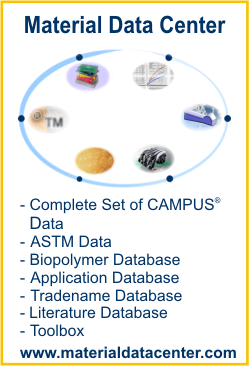Material Data Center is a leading international information system for the plastics industry. Material Data Center offers a comprehensive plastics database, calculation tools, CAE interfaces, a literature database and an application database. For more information about Material Data Center visit www.materialdatacenter.com.
This is the free Material Data Center Datasheet of IMPET® 2700 GV1/20 - PET-GF20 - Celanese
unit conversion, PDF datasheet print, comparison with other plastics, snap fit calculation, beam deflection calculation, CAE Interfaces
Check here, which other Impet datasheets, application examples or technical articles are available in Material Data Center
| Flammability @1.6mm nom. thickn. | HB | - |
| Flammability at thickness h (0.8 mm) | HB | - |
| Caracteristicas de procesamiento y fisicas | Valor | Unidades | Método de ensayo | ||||||||||||||||||||||||||||||||||||||||||||||||||||||||||||||||||||||||||||||||||||||||||||||||
| ISO Data | |||||||||||||||||||||||||||||||||||||||||||||||||||||||||||||||||||||||||||||||||||||||||||||||||||
| Contracción posterior al moldeo, paralelo | 0.3 | % | ISO 294-4, 2577 | ||||||||||||||||||||||||||||||||||||||||||||||||||||||||||||||||||||||||||||||||||||||||||||||||
| Contracción posterior al moldeo, normal | 0.9 | % | ISO 294-4, 2577 | ||||||||||||||||||||||||||||||||||||||||||||||||||||||||||||||||||||||||||||||||||||||||||||||||
| Propiedades mecánicas | Valor | Unidades | Método de ensayo | ||||||||||||||||||||||||||||||||||||||||||||||||||||||||||||||||||||||||||||||||||||||||||||||||
| ISO Data | |||||||||||||||||||||||||||||||||||||||||||||||||||||||||||||||||||||||||||||||||||||||||||||||||||
| Módulo de tracción | 8200 | MPa | ISO 527 | ||||||||||||||||||||||||||||||||||||||||||||||||||||||||||||||||||||||||||||||||||||||||||||||||
| Resistencia a la tracción | 133 | MPa | ISO 527 | ||||||||||||||||||||||||||||||||||||||||||||||||||||||||||||||||||||||||||||||||||||||||||||||||
| Alargamiento a rotura | 2 | % | ISO 527 | ||||||||||||||||||||||||||||||||||||||||||||||||||||||||||||||||||||||||||||||||||||||||||||||||
| Resistencia al impacto Charpy, +23°C | 20 | kJ/m² | ISO 179/1eU | ||||||||||||||||||||||||||||||||||||||||||||||||||||||||||||||||||||||||||||||||||||||||||||||||
| Resistencia al impacto Charpy, -30°C | 20 | kJ/m² | ISO 179/1eU | ||||||||||||||||||||||||||||||||||||||||||||||||||||||||||||||||||||||||||||||||||||||||||||||||
| Resistencia al impacto Charpy c/entalla, +23°C | 6.8 | kJ/m² | ISO 179/1eA | ||||||||||||||||||||||||||||||||||||||||||||||||||||||||||||||||||||||||||||||||||||||||||||||||
| Resistencia al impacto Charpy c/entalla, -30°C | 6.6 | kJ/m² | ISO 179/1eA | ||||||||||||||||||||||||||||||||||||||||||||||||||||||||||||||||||||||||||||||||||||||||||||||||
| Propiedades térmicas | Valor | Unidades | Método de ensayo | ||||||||||||||||||||||||||||||||||||||||||||||||||||||||||||||||||||||||||||||||||||||||||||||||
| ISO Data | |||||||||||||||||||||||||||||||||||||||||||||||||||||||||||||||||||||||||||||||||||||||||||||||||||
| Temperatura de fusión, 10°C/min | 255 | °C | ISO 11357-1/-3 | ||||||||||||||||||||||||||||||||||||||||||||||||||||||||||||||||||||||||||||||||||||||||||||||||
| Temp. de transición vítrea, 10°C/min | 80 | °C | ISO 11357-1/-2 | ||||||||||||||||||||||||||||||||||||||||||||||||||||||||||||||||||||||||||||||||||||||||||||||||
| Estabilidad al calor, 1.80 MPa | 233 | °C | ISO 75-1/-2 | ||||||||||||||||||||||||||||||||||||||||||||||||||||||||||||||||||||||||||||||||||||||||||||||||
| Estabilidad al calor, 0.45 MPa | 248 | °C | ISO 75-1/-2 | ||||||||||||||||||||||||||||||||||||||||||||||||||||||||||||||||||||||||||||||||||||||||||||||||
| Temp. reblandecimiento Vicat, B | 250 | °C | ISO 306 | ||||||||||||||||||||||||||||||||||||||||||||||||||||||||||||||||||||||||||||||||||||||||||||||||
| Coef.de expansión térmica lineal, paralelo | 23 | E-6/K | ISO 11359-1/-2 | ||||||||||||||||||||||||||||||||||||||||||||||||||||||||||||||||||||||||||||||||||||||||||||||||
| Coef.de expansión térmica lineal, normal | 95 | E-6/K | ISO 11359-1/-2 | ||||||||||||||||||||||||||||||||||||||||||||||||||||||||||||||||||||||||||||||||||||||||||||||||
| Combustibilidad a 1.5mm esp. nom. | HB | class | IEC 60695-11-10 | ||||||||||||||||||||||||||||||||||||||||||||||||||||||||||||||||||||||||||||||||||||||||||||||||
| Espesores de probeta | 1.6 | mm | - | ||||||||||||||||||||||||||||||||||||||||||||||||||||||||||||||||||||||||||||||||||||||||||||||||
| Combustibilidad a espesor h | HB | class | IEC 60695-11-10 | ||||||||||||||||||||||||||||||||||||||||||||||||||||||||||||||||||||||||||||||||||||||||||||||||
| Espesores de probeta | 0.8 | mm | - | ||||||||||||||||||||||||||||||||||||||||||||||||||||||||||||||||||||||||||||||||||||||||||||||||
| Combustibilidad según índice de oxigeno | 24 | % | ISO 4589-1/-2 | ||||||||||||||||||||||||||||||||||||||||||||||||||||||||||||||||||||||||||||||||||||||||||||||||
| Propiedades eléctricas | Valor | Unidades | Método de ensayo | ||||||||||||||||||||||||||||||||||||||||||||||||||||||||||||||||||||||||||||||||||||||||||||||||
| ISO Data | |||||||||||||||||||||||||||||||||||||||||||||||||||||||||||||||||||||||||||||||||||||||||||||||||||
| Constante dieléctrica, 100Hz | 4.6 | - | IEC 62631-2-1 | ||||||||||||||||||||||||||||||||||||||||||||||||||||||||||||||||||||||||||||||||||||||||||||||||
| Constante dieléctrica, 1MHz | 4.1 | - | IEC 62631-2-1 | ||||||||||||||||||||||||||||||||||||||||||||||||||||||||||||||||||||||||||||||||||||||||||||||||
| Factor de pérdidas dieléctricas, 100Hz | 30 | E-4 | IEC 62631-2-1 | ||||||||||||||||||||||||||||||||||||||||||||||||||||||||||||||||||||||||||||||||||||||||||||||||
| Factor de pérdidas dieléctricas, 1MHz | 190 | E-4 | IEC 62631-2-1 | ||||||||||||||||||||||||||||||||||||||||||||||||||||||||||||||||||||||||||||||||||||||||||||||||
| Resistividad volumétrica específica | >1E13 | Ohm*m | IEC 62631-3-1 | ||||||||||||||||||||||||||||||||||||||||||||||||||||||||||||||||||||||||||||||||||||||||||||||||
| Resistividad superficial específica | 1E14 | Ohm | IEC 62631-3-2 | ||||||||||||||||||||||||||||||||||||||||||||||||||||||||||||||||||||||||||||||||||||||||||||||||
| Resistencia dieléctrica | 31 | kV/mm | IEC 60243-1 | ||||||||||||||||||||||||||||||||||||||||||||||||||||||||||||||||||||||||||||||||||||||||||||||||
| Otras propiedades | Valor | Unidades | Método de ensayo |
| Absorción de agua | 0.45 | % | Sim. to ISO 62 |
| Absorción de humedad | 0.2 | % | Sim. to ISO 62 |
| Densidad | 1520 | kg/m³ | ISO 1183 |
| Propiedades específicas del material | Valor | Unidades | Método de ensayo | ||||||||||||||||||||||||||||||||||||||||||||||||||||||||||||||||||||||||||||||||||||||||||||||||
| ISO Data | |||||||||||||||||||||||||||||||||||||||||||||||||||||||||||||||||||||||||||||||||||||||||||||||||||
| Indice de viscosidad | 70 | cm³/g | ISO 307, 1157, 1628 | ||||||||||||||||||||||||||||||||||||||||||||||||||||||||||||||||||||||||||||||||||||||||||||||||
| Recomendación para procesamiento Moldeo por inyección | Valor | Unidades | Método de ensayo |
| Temperatura de pre-secado | 120 - 140 | °C | - |
| Tiempo de pre-secado | 2 - 4 | h | - |
| Humedad de procesamiento | ≤0.01 | % | - |
| Temperatura de la masa | 270 - 290 | °C | - |
| Temperatura del molde | 135 - 145 | °C | - |
The time between drying and processing should be kept as short as possible. The processing machine feed hopper should be closed during the processing operation.
Melt Temperature 270-290 °C
Mold Temperature 135-145 °C
Maximum Barrel Residence Time *) 5-10 min
Injection Speed fast
Peripheral screw speed max.0,3 m/sec
Back Pressure 10-20 bar
Injection Pressure 600-900 bar
Holding Pressure 300-500 bar
Nozzle Design open design preferred
Injection speed, injection pressure and holding pressure have to be optimized to the individual article geometry. To avoid material degradation during processing low back pressure and minimum screw speed have to be used. Overheating of the material has to be avoided.
Ticona recommends only externally heated hot runner systems.
*) If the cylinder temperatures are higher than the recommended maximum temperatures, the max. residence time in the barrel has to be reduced.
Material Data Center is provided by M-Base Engineering + Software GmbH. M-Base Engineering + Software GmbH assumes no liability for the system to be free of errors. Any decision about the application of materials must be double checked with the producer of this material.
Additional information about this material, like producer contact address, etc. can be found at www.materialdatacenter.com. For access to this extra information a registration is requested. Free online registration is available.













